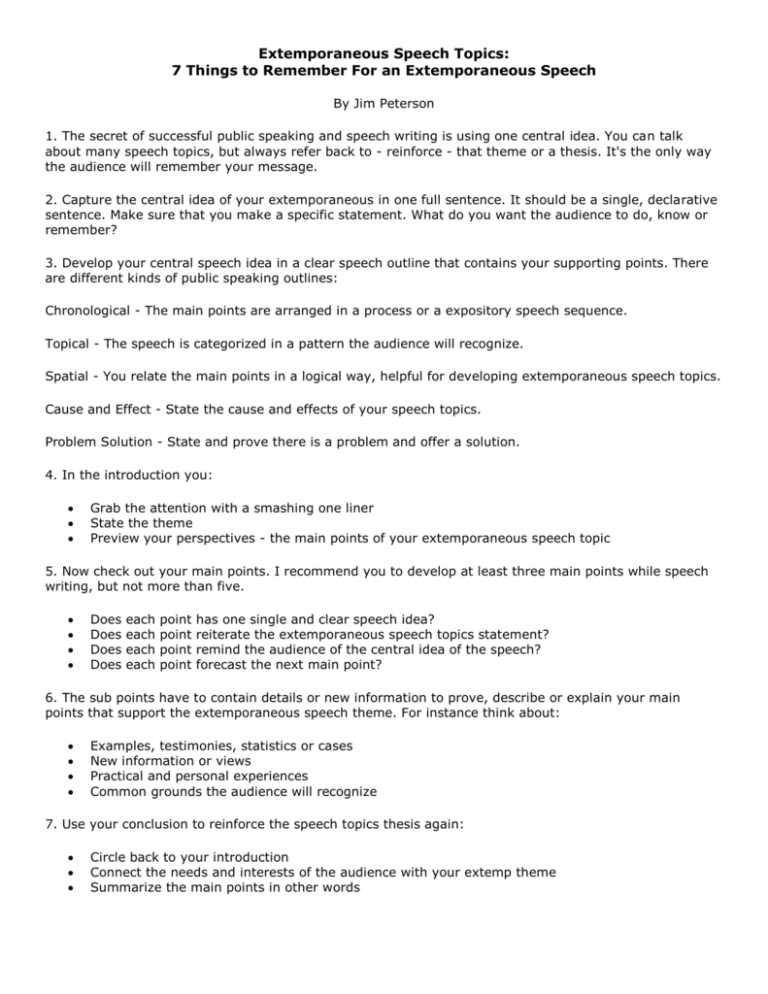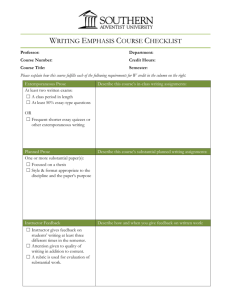Extemporaneous Speech Topics: - Speak Up: Speech & Debate
advertisement

Extemporaneous Speech Topics: 7 Things to Remember For an Extemporaneous Speech By Jim Peterson 1. The secret of successful public speaking and speech writing is using one central idea. You can talk about many speech topics, but always refer back to - reinforce - that theme or a thesis. It's the only way the audience will remember your message. 2. Capture the central idea of your extemporaneous in one full sentence. It should be a single, declarative sentence. Make sure that you make a specific statement. What do you want the audience to do, know or remember? 3. Develop your central speech idea in a clear speech outline that contains your supporting points. There are different kinds of public speaking outlines: Chronological - The main points are arranged in a process or a expository speech sequence. Topical - The speech is categorized in a pattern the audience will recognize. Spatial - You relate the main points in a logical way, helpful for developing extemporaneous speech topics. Cause and Effect - State the cause and effects of your speech topics. Problem Solution - State and prove there is a problem and offer a solution. 4. In the introduction you: Grab the attention with a smashing one liner State the theme Preview your perspectives - the main points of your extemporaneous speech topic 5. Now check out your main points. I recommend you to develop at least three main points while speech writing, but not more than five. Does Does Does Does each each each each point point point point has one single and clear speech idea? reiterate the extemporaneous speech topics statement? remind the audience of the central idea of the speech? forecast the next main point? 6. The sub points have to contain details or new information to prove, describe or explain your main points that support the extemporaneous speech theme. For instance think about: Examples, testimonies, statistics or cases New information or views Practical and personal experiences Common grounds the audience will recognize 7. Use your conclusion to reinforce the speech topics thesis again: Circle back to your introduction Connect the needs and interests of the audience with your extemp theme Summarize the main points in other words How To Deliver Extemporaneous Speech Topics Time Management - The right time management is crucial. Put a watch in front of you. If you have 30 minutes to prepare an extemporaneous speech topic, then divide that time in parts. Below are three examples of time management. Find out which one is the best for you. If you are allowed to use note cards, then the memorize part can be shorter in time, of course. RESEARCH WRITE REFLECT AND MEMORIZE PRACTICE AND POLISH 5 minutes 10 minutes 5 minutes 10 minutes 10 minutes 15 minutes 10 minutes 5 minutes 5 minutes 5 minutes 5 minutes 5 minutes Extemporaneous Outline TOPIC Your topic in one complete summarizing sentence: _______ INTRODUCTION Grab the attention of your public in a oneliner that state the theme. Relate the oneliner to question. State the extemporaneous speech topics question and tell why it is important. Briefly answer it. Tease your main points. BODY The main points in your speech should be phrased as argumentative statements. Devote an equal amount of time at each point. Try to come up with three points. Try to come up with three sub points of the main extemporaneous speech topics. Construct your sub points with credible arguments and factual evidence. Perhaps you can add relevant statistics and references. Think about the pros and cons, likes and dislikes, advantages and disadvantages. Refer in your extemporaneous speech topics to reliable sources, it will enhance your credibility. Write down your the points in one sentence for each point. Just pick out the elements which are appropriate within the time limit! MAIN POINT I: SUB POINT 1: Arguments? Evidence? Statistics? References? SUB POINT 2: Arguments? Evidence? Statistics? References? SUB POINT 3: Arguments? Evidence? Statistics? References? MAIN POINT II: SUB POINT 1: Arguments? Evidence? Statistics? References? SUB POINT 2: Arguments? Evidence? Statistics? References? SUB POINT 3: Arguments? Evidence? Statistics? References? MAIN POINT III: SUB POINT 1: Arguments? Evidence? Statistics? References? SUB POINT 2: Arguments? Evidence? Statistics? References? SUB POINT 3: Arguments? Evidence? Statistics? References? CONCLUSION Summarize the main points of your extemporaneous topics. State the question again. State your answer in a catchy one-liner.






